The Leading Edge: October 2021 Wind Energy Newsletter
In this edition, President Biden and U.S. Department of Energy (DOE) leaders visit NREL, a researcher makes headlines, and, in time for Halloween, consider new ways to protect bats.
News Stories
President Biden Visits NREL
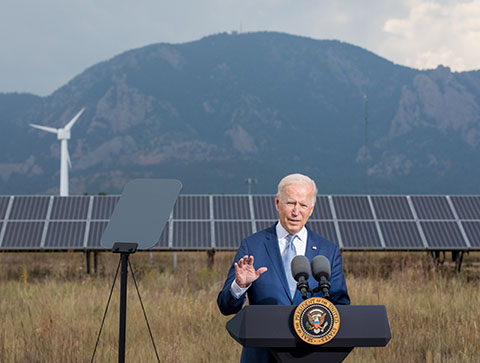
NREL's exciting visit. Joe Biden, president of the United States, speaks during a visit to NREL's Flatirons Campus in Colorado. The president received insight into NREL's long-term research mission, vision, and critical objectives that directly align with his decarbonization goals and national energy priorities. Photo by Werner Slocum, NREL
On Sept. 14, 2021, U.S. President Joe Biden spoke at NREL while standing in front of wind turbines on the lab's Flatirons Campus.
Biden, the third president to visit NREL, addressed climate change and its impacts. As an example, Biden cited this summer’s massive mudslide that washed out a section of Colorado's Interstate 70, a main artery not just for Coloradans commuting to work but also for national commercial transport. “Extreme weather is only going to come more frequently and with more ferocity,” the president said. “We’re blinking code red as a nation.”
“We know what the driver is: climate change. We know what’s causing climate change: human activity. This is no longer subject to debate,” the president said. “And, I might add, windmills do not cause cancer.”
The president also pointed out the work being done to combat climate change, including how NREL is leading the charge to advance clean energy research and technologies. “We’ll be making one of those breakthroughs in solar, wind, and storage out of these facilities,” he said.
During the visit, Daniel Laird, center director of the National Wind Technology Center (NWTC), gave the president a tour of some ongoing research, including work on recyclable wind turbine blades. “I had a chance today to see wind-turbine testing and new battery technologies,” Biden said. “Because of the years of work that have taken place here, these technologies aren’t science fiction. They’re ready to be installed across the country right now.”
A presidential view. President Biden (second from right), Secretary of Energy Jennifer Granholm (second
from left), and NREL Laboratory Director Martin Keller (far left) listen to NWTC Center
Director Daniel Laird (far right) as they view a wind turbine blade at NREL's Flatirons
Campus. Photo by Werner Slocum, NREL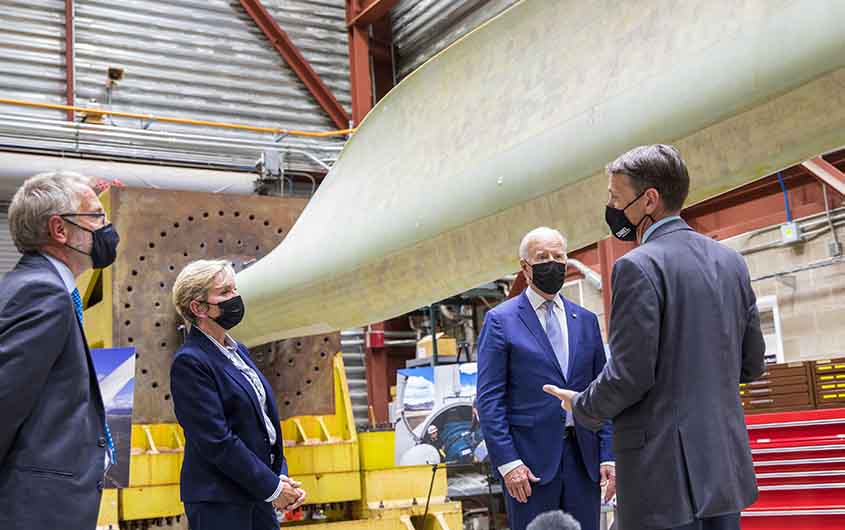
NREL Laboratory Director Martin Keller said, “I was honored to welcome President Joe Biden to NREL's Flatirons Campus today and show him some of the ways that our national laboratory is at work to achieve our country’s clean energy goals.”
Joining Biden on campus was Assistant Secretary and Principal Deputy Assistant Secretary of Energy Efficiency and Renewable Energy Kelly Speakes-Backman as well as other White House, DOE, and local elected officials, including Colorado Governor Jared Polis.
The White House livestreamed Biden’s remarks at NREL live on YouTube. But the visit earned far more local and national coverage in outlets from The Denver Post and The Denver Gazette to The New York Times. A Washington Post article noted the president “spoke after touring the campus, where he observed a demonstration of the wind turbine,” known as “The Blade.” A photo shared by KDVR shows Biden reaching out to touch a wind turbine blade on NREL's Flatirons Campus. A similar photo led Newsy’s video coverage of the talk. The Denver Gazette wrote, the lab is “where enormous, advanced wind turbines undergo testing.”
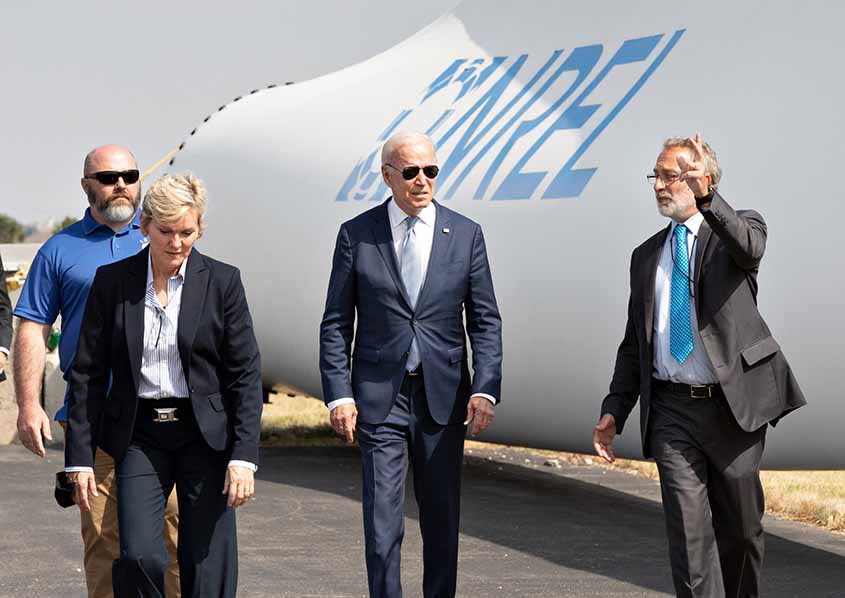
A presidential view. Passing in front of a wind turbine blade at NREL's Flatirons Campus, President Biden (middle) walks with Martin Keller (right) and Jennifer Granholm (left). Photo by Werner Slocum, NREL
Deputy Secretary and Secretary of Energy Visit NREL
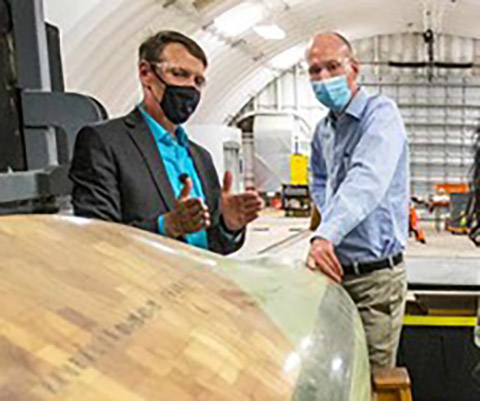
Eyes on the blades. Daniel Laird (left) talks with David Turk in NREL's Composites Manufacturing Education and Technology Facility. Photo by Werner Slocum, NREL
A week before the president's visit, the deputy secretary of energy, David M. Turk, toured NREL's Flatirons Campus and its Composites Manufacturing Education and Technology Facility. Associate Laboratory Director for Mechanical and Thermal Engineering Science Johney Green and Laird explained how the NWTC is leading the United States in advancing critical technologies and systems to meet national decarbonization goals.
And the day after Speakes-Backman joined Biden on campus, she made a second visit to NREL to get a closer look at the lab's research. “This is so cool,” she said after donning a pair of visualization glasses in NREL's 3D visualization room at the Energy Systems Integration Facility. “Fluid dynamics was my favorite class, and this is amazing.”
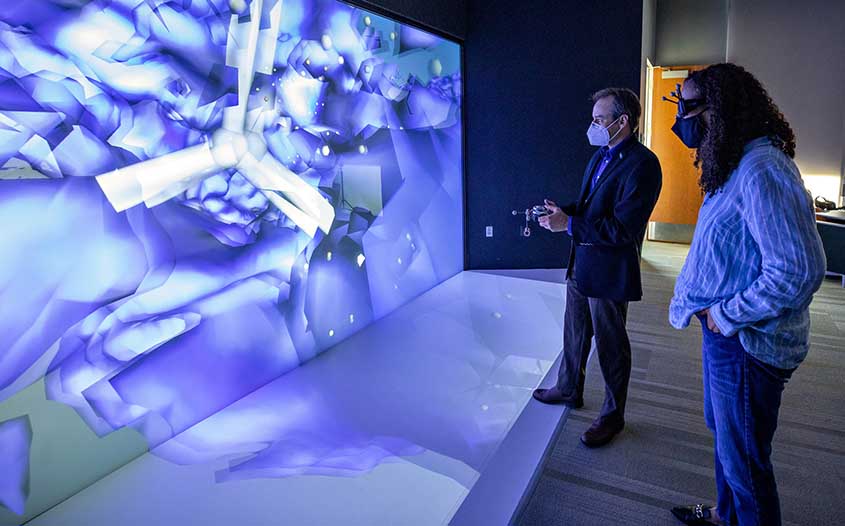
Seeing wind energy. An NREL scientist (left) explains a 3D visualization model to Kelly Speakes-Backman during a tour stop at the 3D visualization room at the Energy Systems Integration Facility. Photo by Werner Slocum, NREL
Behind the Blades
Meet an NREL Wind Energy Researcher
Before renewable wind energy is installed across the United States, researchers must
first consider where they are deployed.

Winds of change. Anthony Lopez deviated from his family's history of working in a factory or the military to attend college and become a geospatial data scientist. At NREL, he researches how land use can impact wind energy development and clean energy goals.
Anthony Lopez, who has been at NREL for almost 10 years, is a senior geospatial data scientist in NREL's Strategic Energy Analysis Center. He focuses on modeling land-use constraints for wind energy—identifying both availability of wind that can generate power as well as limitations on wind power plant locations—an emerging area of research in the clean energy transition. “We’ve never worried about having enough wind to power the country,” he said. “But we’re finding in new research that local land use restrictions have real national implications that could make it difficult to meet clean energy targets.”
Lopez's ancestors were one of 45 families that moved from New Mexico to Greeley, Colorado, in 1924 to work at a sugar beet factory. With support from the Greeley Dream Team, a nonprofit organization that helps limited-income minority students succeed in school and dare to dream bigger, he attended the University of Northern Colorado to study geography. He then worked at a private environmental firm and partnered with the Bureau of Land Management while teaching himself to code in his free time.
Now, at NREL, Lopez and his team are developing wind supply curves—which characterize the quantity, quality, and cost of land-based and offshore wind resources—and working to reflect population growth and economics of various wind plant designs with NREL models—even considering ecology. This work will identify locations where new wind plants can maximize energy production and minimize costs. Learn more about Lopez's journey and this work, which was recently featured by the Wall Street Journal and The New York Times.
On the Radar
NREL Seeks Proposals for Bat Research
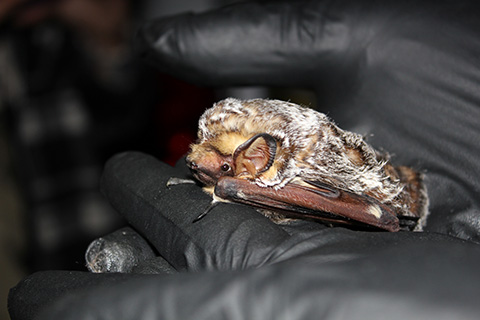
Going batty. NREL is requesting proposals to fund research to better understand how bats, like this one, interact with wind turbines and power plants as well as how to improve deterrents. Photo by Cris Hein, NREL
Bats are at the fore of many minds during the spooky season. At NREL, researchers work year-round to investigate how wind energy impacts wildlife—and specifically bats.
To support the coexistence of bats and wind energy in the United States, NREL has announced a new request for proposals for research on bat behavior near wind turbines and power plants and improved deterrents to help keep bats safe. Submissions are due Dec. 8, 2021, and up to four winners will receive $450,000–$700,000 each to fund their projects. Clean energy is vital to our planet's health—and so are bats.
A Change in the Wind: New Process for Collegiate Wind Competition
Since 2014, DOE's Collegiate Wind Competition has helped prepare college students for jobs in wind energy and other sustainable energy industries through hands-on experience with wind energy technologies, project development, and outreach experience.
Historically, the Collegiate Wind Competition has released a request for proposals inviting student teams to apply. But for the 2023 competition, the process has changed. Competition organizers will release a new application in March 2022 that they hope will engage a broader range of students to build the skills and professional connections to help them break into the wind energy industry.
Catching wind of new competition. Students who participate in DOE's Collegiate Wind Competition get the opportunity
to design, build, and test a prototype wind turbine like the one pictured here. This
real-world, hands-on experience helps prepare participants for jobs in the fast-growing
wind energy industry. The competition will switch to a new, registration-based application
for the 2023 event. Photo by Werner Slocum, NREL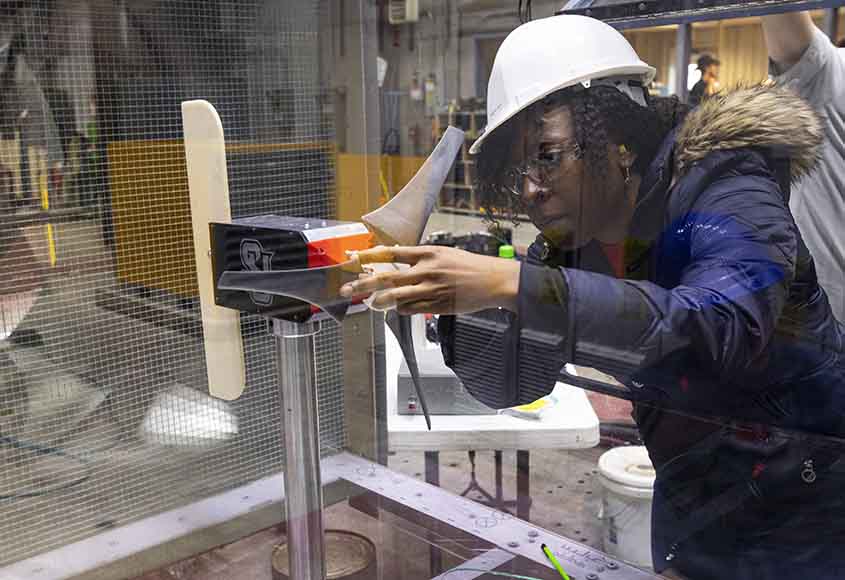
A Conversation With Energy Secretary Granholm
Secretary of Energy Jennifer Granholm was the special guest of the North American Wind Energy Academy (NAWEA) in a webinar that featured a dialogue with University of Delaware hosts. The webinar is one in a series, coordinated by NREL's Kelsey Shaler and other conference committee members, positioned as an “interim event” because of the postponement of the NAWEA/WindTech Conference until 2022. They discussed educational initiatives, the need for cross-disciplinary work to achieve administration goals, and the importance of the administration's Build Back Better plan for meeting long-term goals. Secretary Granholm also mentioned how impressed she was with the technology she saw being developed during her recent visit to NREL's Flatirons Campus. Learn more about the NAWEA/WindTech 2021 Interim Events, sponsored by DOE and NREL.
Offshore WINDPOWER Conference
NREL wind energy researcher Matt Shields spoke at American Clean Power’s Offshore WINDPOWER Conference and Exhibition during the “Building a Lasting Supply Chain” panel on Oct. 14, 2021.
Downwind: In Case You Missed It
Just Released: Fall 2021 Wind R&D Newsletter
Check out the Fall 2021 edition of the biannual DOE Wind Research and Development Newsletter! You’ll get an update on the National Offshore Wind Research and Development Consortium, established by DOE's Wind Energy Technologies Office (WETO) in 2018 to drive critical innovation in the U.S. offshore wind energy industry. Other articles highlight the latest research on the big future (literally) of offshore wind energy, growing awareness about its environmental effects, an updated model that captures the subtleties of cold-pool events and could lead to improved wind power forecasts, and more. Subscribe to learn more about WETO’s R&D projects, news, accomplishments, and recent publications.
NREL Pinpoints Novel Method To Move Larger Wind Turbine Blades Across Country
Transporting massive wind turbine blades can be difficult and costly. To overcome logistical constraints, industry offers segmented designs, which are more costly than single-piece blades. Now, NREL researchers have determined an alternative way to transport monolithic wind turbine blades. Blades are designed so they can bend while traveling along curving railroad tracks. This “controlled flexing” could allow land-based wind turbine blades of 100 meters (the length of four railcars) or more to be transported in one piece; the previous cap for rigidly transported blades was 75 meters.
“This research can aid in massive deployment of wind energy in different regions of the country—even parts of the country that typically haven't seen as much deployment,” said Nick Johnson, a mechanical engineer at NREL's NWTC and co-lead of DOE's Big Adaptive Rotor Project. The paper, published in the journal Wind Energy Science, was co-authored by NREL-s Pietro Bortolotti and Nikhar Abbas and three researchers at Sandia National Laboratories and has since been highlighted by media, including Yahoo Finance, Windpower Monthly, Global Newswire, and Cleantechnica.
NREL and General Electric Operate Type 3 Wind Turbine in Grid-Forming Mode for First Time
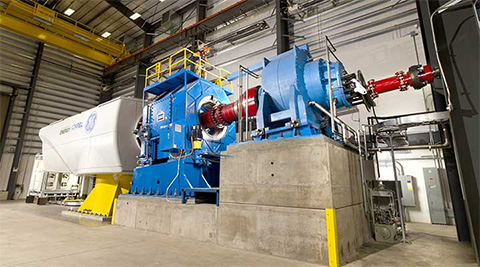
World's first. NREL's 5-megawatt dynamometer was a prime mover for General Electric's Type 3 generator drivetrain. For the first time, NREL and General Electric have demonstrated a Type 3 utility-scale wind turbine generator operating in grid-forming mode. Photo by Werner Slocum, NREL
Researchers from NREL and General Electric have developed and demonstrated the world's first Type 3 utility-scale wind turbine generator, also known as a double-fed induction generator, which can operate in grid-forming mode, meaning it can jump-start the grid during a blackout or operate loads without a power grid.
Typically, to restart the grid after a blackout, grid operators must rely on conventional energy sources, such as hydropower or natural gas plants, before adding solar or wind. This new capability to operate independently—and recover from total or partial shutdown—could provide improved grid response to disturbances and even support island power grids, creating new market opportunities for this type of wind turbine.
The demonstration, part of the Wind as a Virtual Synchronous Generator project, funded by WETO, was conducted using NREL's 5-megawatt dynamometer as a prime mover for General Electric's Type 3 generator drivetrain, incorporating capabilities of NREL's Advanced Research on Integrated Energy Systems research platform. Additional experiments will be performed in the first quarter of Fiscal Year 2022.
Offshore Wind Pipeline Grows
News channels continue to share highlights from the Offshore Wind Report: 2021 Edition, which was authored by NREL offshore wind researchers and published by DOE along with land-based and distributed wind reports at the end of August. Daily Energy Insider shared details from the report, such as the 24% growth the offshore wind industry pipeline saw in 2020 to early 2021.
Recent Publications
Drivetrain Reliability Collaborative 1.5 Projects: Joint Industry Megawatt-Scale Drivetrain Field Experiments
Two cooperative research and development final reports describe field testing on a commercial multimegawatt wind turbine drivetrain to collect operational data as installed in the turbine. NREL researchers used this data to characterize drivetrain loads and responses during actual in-field conditions. In one report, NREL researchers measured the operational conditions (loads, temperature, electrical current, and slip) on the high-speed-shaft bearings in the gearbox to characterize suspected contributors to the bearing white-etch cracking failure mode. In the other, NREL researchers measured the operational conditions (loads, motion, temperature, electrical current, and lubrication) on the main bearing to characterize main bearing wear and micropitting failure modes. This research contributes to publicly available operational data, which will help the wind energy industry develop improvements in gearbox and drivetrain components, the lubrication system, or the turbine controller.
Wind Turbine Drivetrain Reliability and Wind Plant Operations and Maintenance Research and Development Opportunities
The wind energy industry has seen tremendous growth over the past two decades. At the same time, the cost of energy from wind has decreased thanks to lower capital costs, higher production, and more efficient operation. However, wind power plant operational expenditures are still an appreciable contributor to the overall cost of wind energy. The Drivetrain Reliability Collaborative, a consortium led by NREL and Argonne National Laboratory, hosts focused seminars and annual meetings to bring researchers and stakeholders throughout the drivetrain supply chain together to exchange information on the latest research and development, operational challenges, and future opportunities. This technical report summarizes research and development opportunities identified at the most recent meetings.
Challenges, Opportunities, and a Research Roadmap for Downwind Wind Turbines
In the 1980s, wind turbine rotors were designed in both upwind and downwind configurations. The latter suffered, however, from low-frequency noise emissions and increased fatigue issues. With rotor sizes and blade designs changing over the past 40 years, interest in downwind configurations is reviving because they offer the possibility to overcome design constraints, reduce blade mass, and lower costs. Recently, researchers at NREL and Japan-based Hitachi Ltd. published a discussion of the challenges and advantages of downwind turbines in Wind Energy. The team found that downwind rotors produce less energy annually because of an inherently smaller rotor swept area but their lightweight designs decrease capital costs. The overall comparison in terms of levelized cost of energy does not return a clear winner, and the article suggests areas where downwind turbines may offer additional advantages compared to those upwind, namely advanced controls, highly tilted rotors, higher-fidelity aerodynamic models, and offshore floating platforms. In parallel to these four areas, the article recommends an experimental campaign to clarify whether infrasound noise and increased fatigue are issues still relevant to modern turbine configurations.
Objective and Algorithm Considerations When Optimizing the Number and Placement of Turbines in a Wind Power Plant
Changing the layout of wind turbines in a wind energy plant can affect their efficiency. Often, research focuses on optimizing the turbine layout while assuming the number of turbines is known. In a new study published in Wind Energy Science, NREL researchers optimize the number of wind turbines, as well as their placement, to maximize the performance of a wind power plant. Using a Gaussian wake model to predict the downstream reduction of wind speed within NREL's FLOw Redirection and Induction in Steady State model framework, the team found that the optimal number of wind turbines depends on the optimization objective. For example, minimizing the cost of energy will result in a drastically different solution than maximizing the profit. In fact, the profit of a hypothetical wind plant could vary by $2 million annually depending on the objective of the optimization. The paper also compares and contrasts several optimization algorithms, all of which show the strong dependence on the optimized objective.
Structural Testing Technology Development
NREL's Flatirons Campus, which hosts the NWTC, houses many wind turbines, components, and systems. Some are used for research, but the facility's capabilities also make it one of the only accredited testing site in the United States that meets the standards of the International Electrotechnical Commission for full-scale wind blade structural validation. Working with Mitsubishi Power Systems, NREL can expand blade and drivetrain capabilities while helping Mitsubishi Power Systems improve its wind energy products. For the collaboration, which included cutting composite wind turbine blades for postmortem inspection, NREL completed the full-scale structural validation to several blades.
Share

